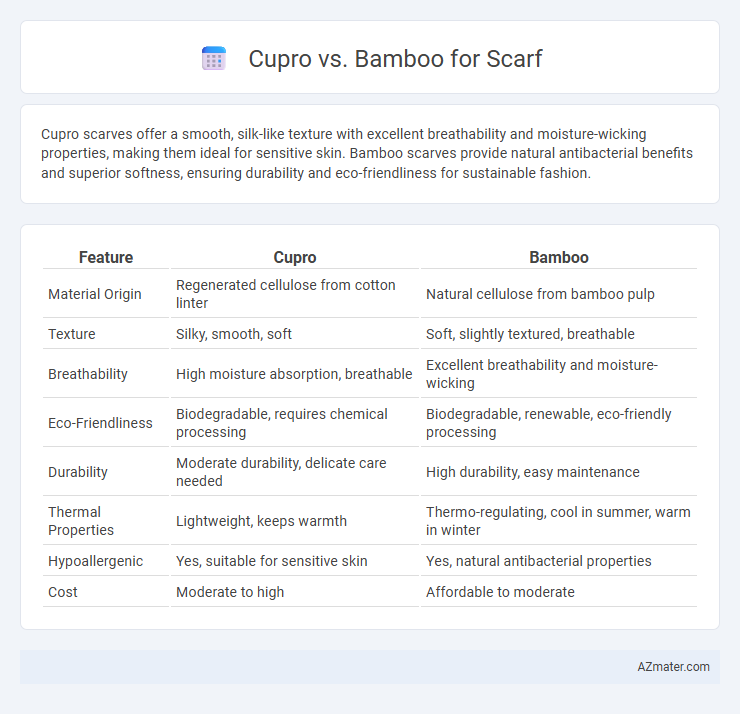Cupro scarves offer a smooth, silk-like texture with excellent breathability and moisture-wicking properties, making them ideal for sensitive skin. Bamboo scarves provide natural antibacterial benefits and superior softness, ensuring durability and eco-friendliness for sustainable fashion.
Table of Comparison
| Feature | Cupro | Bamboo |
|---|---|---|
| Material Origin | Regenerated cellulose from cotton linter | Natural cellulose from bamboo pulp |
| Texture | Silky, smooth, soft | Soft, slightly textured, breathable |
| Breathability | High moisture absorption, breathable | Excellent breathability and moisture-wicking |
| Eco-Friendliness | Biodegradable, requires chemical processing | Biodegradable, renewable, eco-friendly processing |
| Durability | Moderate durability, delicate care needed | High durability, easy maintenance |
| Thermal Properties | Lightweight, keeps warmth | Thermo-regulating, cool in summer, warm in winter |
| Hypoallergenic | Yes, suitable for sensitive skin | Yes, natural antibacterial properties |
| Cost | Moderate to high | Affordable to moderate |
Introduction to Cupro and Bamboo Fabrics
Cupro is a regenerated cellulose fiber made from cotton linter, known for its silky texture, breathability, and eco-friendly production process, making it a luxurious choice for scarves. Bamboo fabric, derived from bamboo pulp, offers natural antibacterial properties, moisture-wicking abilities, and excellent softness, ideal for all-season scarves that prioritize comfort and sustainability. Both materials are biodegradable and renewable, providing stylish, lightweight, and hypoallergenic options for eco-conscious consumers.
What is Cupro? Origins and Properties
Cupro, also known as cuprammonium rayon, is a regenerated cellulose fiber derived from cotton linter, a byproduct of cotton processing. Originating in Japan in the early 20th century, Cupro is prized for its silk-like softness, breathability, and excellent moisture absorption, making it an ideal fabric for scarves. Its smooth texture and hypoallergenic properties provide comfort while maintaining durability and vibrant color retention over time.
What is Bamboo Fabric? Production and Characteristics
Bamboo fabric is derived from the cellulose fibers of the bamboo plant, produced through mechanical processing or chemical methods like viscose or lyocell production, resulting in a soft, breathable, and moisture-wicking textile ideal for scarves. Its natural antibacterial properties and sustainability make it a popular choice in eco-conscious fashion, offering durability and hypoallergenic qualities. Compared to Cupro, bamboo fabric provides superior moisture management and environmental benefits, while maintaining comfort and a smooth texture for sensitive skin.
Sustainability: Cupro vs Bamboo
Cupro is a regenerated cellulose fiber made from cotton linter, offering a biodegradable and chemically recycled material that reduces waste and minimizes environmental impact. Bamboo fabric, derived from bamboo pulp, is often marketed as eco-friendly due to bamboo's fast growth and low water needs, but the chemical-intensive viscose process used in its production raises sustainability concerns. Choosing scarves made from certified organic bamboo or closed-loop cupro processes enhances sustainability by reducing harmful chemicals and conserving resources.
Softness and Comfort Comparison
Cupro fabric offers exceptional softness and a smooth, silky texture that feels luxurious against the skin, making it ideal for scarves worn close to the face. Bamboo fibers are naturally breathable and moisture-wicking, providing a soft, lightweight comfort with inherent antibacterial properties that enhance wearability throughout the day. Overall, Cupro excels in silky smoothness while Bamboo delivers superior breathability and a natural, cozy softness for all-day comfort.
Breathability and Moisture-Wicking Abilities
Cupro fabric, derived from regenerated cellulose fibers, offers excellent breathability due to its fine, porous structure that allows air circulation, making it ideal for scarves in warmer climates. Bamboo fiber is naturally moisture-wicking and antibacterial, effectively drawing sweat away from the skin and keeping the wearer dry and comfortable during extended use. Compared to bamboo, Cupro provides a silk-like smoothness with slightly less moisture management but superior airflow, while bamboo excels in absorbing moisture and odor resistance, making both fabrics highly functional for breathable, moisture-wicking scarves.
Durability and Longevity
Cupro scarves exhibit exceptional durability due to their regenerated cellulose fibers, which resist pilling and retain shape after multiple washes, ensuring long-lasting wear. Bamboo fibers offer natural antimicrobial properties and moisture-wicking benefits but tend to be softer and more prone to stretching or wear over time. Choosing Cupro guarantees a sturdier fabric ideal for daily use, while Bamboo scarves require gentler care to maintain their structural integrity.
Style and Aesthetics for Scarves
Cupro scarves offer a luxurious silk-like sheen and smooth texture, enhancing elegant and sophisticated styles with a subtle lustrous finish. Bamboo scarves provide a natural matte look with a soft drape, ideal for casual and eco-friendly fashion statements that emphasize comfort and understated beauty. Both fabrics allow versatile styling, but Cupro excels in refined aesthetics while Bamboo leans towards organic, earthy appeal.
Skin Sensitivity and Hypoallergenic Properties
Cupro fabric, derived from cotton linter, is highly breathable and naturally hypoallergenic, making it ideal for individuals with sensitive skin prone to irritation. Bamboo fabric, known for its antimicrobial and moisture-wicking properties, also offers excellent softness but may sometimes cause allergic reactions in very sensitive users due to residual chemicals from processing. For scarves catering to skin sensitivity, Cupro's smooth texture and minimal chemical use provide superior comfort and reduce the risk of allergic responses compared to bamboo alternatives.
Final Verdict: Which is Better for Scarves?
Cupro scarves offer a luxurious silk-like feel with excellent breathability and moisture-wicking properties, making them ideal for sensitive skin and all-day comfort. Bamboo scarves are highly sustainable, naturally antibacterial, and provide exceptional softness and durability, perfect for eco-conscious consumers seeking long-lasting wear. For scarves, the final verdict favors bamboo due to its superior sustainability and natural antibacterial benefits, while cupro remains a strong choice for those prioritizing silky texture and breathability.

Infographic: Cupro vs Bamboo for Scarf
 azmater.com
azmater.com